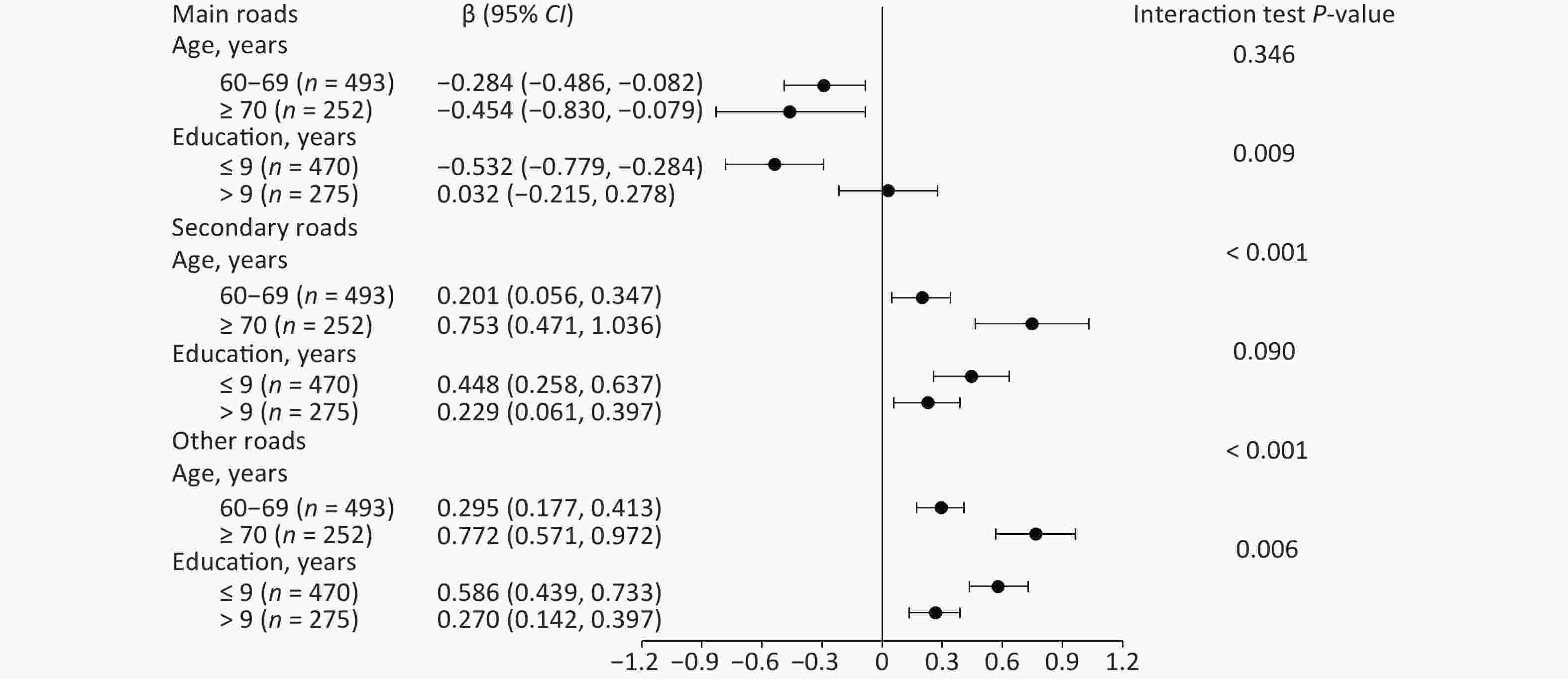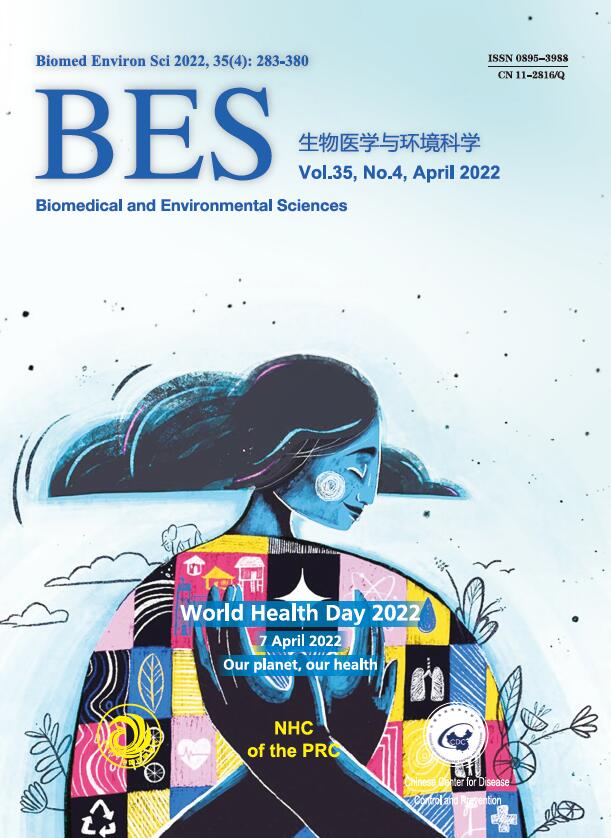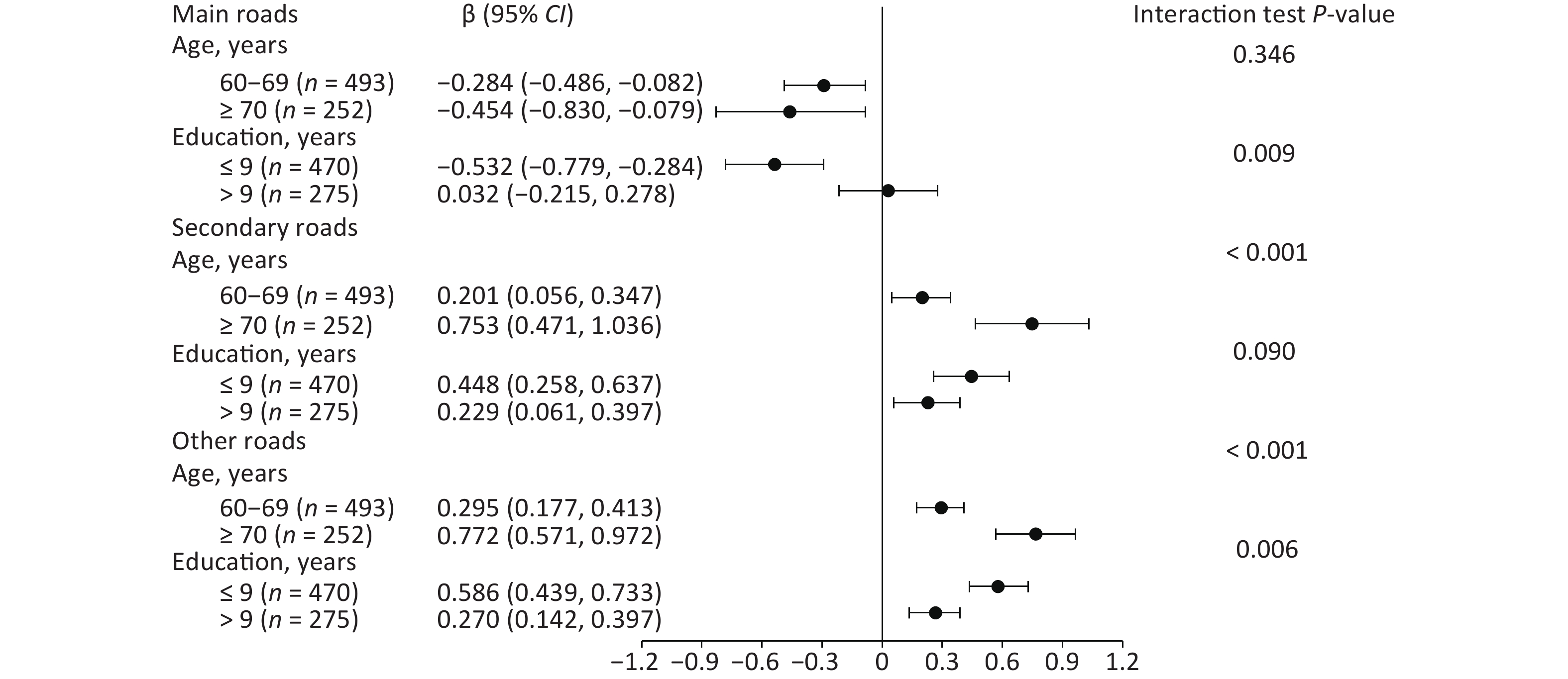-
A good built environment is a basic element for supporting active and healthy aging. The built environment can change individual behaviors, stimulate cognitive activities, and potentially affect cognitive health. A growing number of studies have explored many features of the built environment, such as land use mix and destination accessibility, that are related to cognitive health. As an important component of the built environment, road network density is used to evaluate the traffic conditions in a certain area and reflect the regional spatial structure. Exposure to greater road density contributes to the deterioration of health conditions and increased risk of mortality owing to cerebrovascular or cardiovascular disease, among other causes[1,2]. Studies have also shown that road proximity is associated with cognitive impairment and the incidence of non-Alzheimer dementia, Parkinson’s disease, and Alzheimer disease (AD)[3,4]. Therefore, analyzing the relationship between road network density and cognition can further our understanding of the impact of roads on cognition. In addition, with trends of rapid urbanization and an expanding road network, road density has become a dominant factor in air pollutant concentration[5]. Because air pollution is also related to cognitive decline[6], the impact of air pollution should be taken into account when studying the relationship between road networks and cognition.
China is undergoing rapid urbanization, coupled with serious air pollution and an increasing prevalence of impaired cognitive function [7], making it important to explore the impact of the built environment on levels of cognition. The study of environmental characteristics, such as road network density and air pollution, can further our understanding of potential influencing factors in the living environment that may affect cognitive health so as to improve cognitive health via environmental regulation.
We performed this study in three cities (Shenyang, Anshan, and Fuxin) in Liaoning Province, China, in 2017. We selected two municipal districts from each city, five community health care centers from each municipal district, and 25 older people from each community health care center. Each community health care center managed multiple communities. Participants were individuals who went to the community health care center for physical examinations but were not patients. We recruited people aged 60 and older who could complete the survey on their own. Exclusion criteria included clinically diagnosed with dementia or AD, deaf or nonverbal, and cerebral hemorrhage within the past six months. We excluded three participants who had missing cognitive test scores and two participants who were missing years of community residence, leaving a final sample size of n = 745. We obtained approval for the study from the Ethical Committee of China Medical University, and we received consent from all participants.
Road network density refers to the ratio of total mileage of a road network to a certain area. We used OpenStreetMap to obtain the total length of all roads within a 0.8 km radius buffer centered on the centroid of the community where participants were located in 2017. We used QGIS v3.14.15 for road length acquisition and calculation. In addition, we divided the total roads into three categories: main roads, secondary roads, and other roads.
We used the air quality index (AQI), obtained from the national urban air quality real-time release platform of the China National Environmental Monitoring Centre to assess individual air pollution exposure levels. Considering that cognitive change is a long-term process, we collected available air pollution data for the three years before the survey. We obtained the annual average value of air pollution by calculating three-year air pollution monitoring data and the average air pollution during the heating period and the non-heating period by calculating air pollution data for the five months from November to March of the following year and for the seven months from April to October, respectively. The inverse distance formula was used to calculate the average air pollution concentration within a 10 km radius centered on the centroid of the communities in which participants lived.
We measured cognitive function with the Mini-Mental State Examination (MMSE) in face-to-face sessions. The MMSE has previously been validated in the Chinese population, with good sensitivity and specificity. The MMSE is a 30-point questionnaire that is commonly used to measure cognitive status in studies of older adults, with higher scores indicating better cognitive function.
We collected information on age, sex, education (≤ 9 years or > 9 years), income (< RMB 50,000 or ≥ RMB 50,000), marital status (married, never married, divorced, or widowed), length of community residence, number of people living together in the same household, and chronic disease history (presence or absence of hypertension, diabetes, hyperlipidemia, and coronary atherosclerotic heart disease) using the questionnaire. To control for air pollution caused by heating, we also collected the number of all chimneys belonging to heating companies within a 0.8 km radius buffer centered on the centroid of the community where participants lived.
We conducted all statistical analyses using IBM SPSS Statistics 23.0 (IBM Corp., Armonk, NY, USA) and R 4.1.0 (The R Project for Statistical Computing, Vienna, Austria). We reported descriptive statistics of the study population and exposure assessment as percentage, mean (standard deviation) or median (interquartile range). First, we used multivariate linear regression to evaluate the relationship between the three categories of road network density (main road network density, secondary road network density and other road network density) and cognitive function, and the relationship between people in different age groups and different education levels. We then used mediation analysis to evaluate the role of air pollution in three periods (the whole year, the heating period, and the non-heating period) for the three categories of road network density and cognitive function.
Participants had an average age of 67.8 ± 6.2 years and an average MMSE score of 25.8 ± 3.2 (Supplementary Table S1, available in www.besjournal.com). The median and interquartile range of network density for main roads, secondary roads and other roads in communities inhabited by participants was 1.14 (0.31, 1.58), 0.98 (0.60, 2.05), and 3.31 (2.40, 3.31), respectively (Supplementary Table S2, available in www.besjournal.com).
Characteristics Mean ± SD/n (%) Age, years (mean ± SD) 67.8 ± 6.2 Sex (n, %) Male 256 (34.4) Female 489 (65.6) Education, years (n, %) ≤ 9 470 (63.1) > 9 275 (36.9) Marital status (n, %) Married 608 (81.6) Never married 8 (1.1) Divorced 20 (2.7) Widowed 109 (14.6) Annual household income, RMB (n, %) < 50,000 403 (54.1) ≥ 50,000 342 (45.9) Number of people in household (n, %) 1 82 (11.0) 2 513 (68.9) 3 63 (8.5) ≥ 4 87 (11.7) Length of community residence, years (M, IQR) 18 (10, 30) Chronic disease history (n, %) No 317 (42.6) Yes 428 (57.4) MMSE test score (mean ± SD) Total score 25.8 ± 3.2 Note. Chronic disease history represents any positive medical history for hypertension, diabetes, hyperlipidemia, or coronary atherosclerotic heart disease. SD, Standard deviation; M, Median; IQR, Interquartile range; MMSE, Mini-Mental State Examination. Table S1. Characteristics of the study population (n = 745)
Characteristics Mean ± SD/M (IQR) Range Exposure variables Road network density, km/km2 Main roads 1.14 (0.31, 1.58) (0, 4.63) Secondary roads 0.98 (0.60, 2.05) (0, 5.71) Other roads 3.31 (2.40, 3.31) (0.28, 10.43) Air quality index Whole year 91.49 ± 9.31 (76.56, 112.50) Heating period 112.34 ± 15.68 (86.82, 141.61) Non-heating period 76.60 ± 5.05 (69.23, 91.71) Number of chimneys of heating companies 1 (0, 2) (0, 8) Note. SD, Standard deviation; M, Median; IQR, Interquartile range. Table S2. Characteristics of related environmental factors
The results showed that different categories of road had different impacts on participants. After adjusting for sociodemographic factors, the relationship between main road network density and cognitive function was significant and negative (β < 0; P < 0.05). However, secondary road network density (β > 0; P < 0.05) and other road network density (β > 0; P < 0.05) had a positive correlation with cognitive function. These associations were stable to further adjustments for marital status, household size, disease history, and residential years (Table 1).
Model Main roads Secondary roads Other roads Model 1 −0.366 (−0.548, −0.183) 0.357 (0.222, 0.491) 0.452 (0.348, 0.556) Model 2 −0.348 (−0.530, −0.167) 0.360 (0.226, 0.493) 0.447 (0.344, 0.550) Model 3 −0.346 (−0.528, −0.164) 0.363 (0.230, 0.497) 0.452 (0.348, 0.555) Model 4 −0.349 (−0.531, −0.167) 0.366 (0.232, 0.499) 0.452 (0.349, 0.556) Note. Model 1 controlling for age, sex, education, annual household income. Model 2 controlling for age, sex, education, annual household income, marital status, and household size. Model 3 controlling for age, sex, education, annual household income, marital status, household size, and chronic disease history. Model 4 controlling for age, sex, education, annual household income, marital status, household size, chronic disease history, and length of community residence. Table 1. Adjusted βs and 95% confidence intervals of road network density and cognitive function
Different roads have different characteristics and functions. Main roads connect cities with the outside world and include national highways, provincial highways, and ring roads. Therefore, main roads are generally open to heavy trucks and have the largest traffic volume. Secondary roads connect the main areas of a city and include arterial roads. The main traffic tasks of the city occur on these roads, which form the skeleton of the urban road network. Other roads refer to roads in various areas of a city except for main roads and secondary roads, and they play a role in the concentration and distribution of traffic as well as service functions. The beneficial effects of road networks on cognition may arise from the promotion of physical activity and maintenance of social communication with a high road network density [8]. However, compared with secondary roads and other roads, main roads have few nonmotorized vehicles, larger traffic volume, and lower land use mix in the surrounding areas. As a result, main roads have a limited effect on promoting physical activity and social interaction and are therefore not conducive to healthy cognition.
The results of stratified analysis showed that associations of secondary road network density and the other road network density with cognitive function were stronger in participants aged 70 and above than in those aged 60–69 years (P for interaction < 0.001). Associations of main road network density and other road network density with cognitive function were stronger in participants with less than 9 years’ education than in those with more than 9 years’ education (P for interaction 0.009 and 0.005, respectively) Figure 1. Older people are more dependent on the community and surrounding environment than when they were younger, and this population is more susceptible to the influence of the surrounding environment [9]. Dense road networks, especially secondary and other roads, make it easier for older people to access libraries and parks to engage in communication or recreational activities, which may provide cognitive stimulation and benefit cognitive health. Education level also showed an interaction with road network density and cognitive function. Cognitive reserve reflects an individual's ability to provide a buffer against the effects of dementia-related brain pathology. Generally, cognitive reserve is better with higher education levels, which may improve an individual's ability to resist neuropathy. Studies have shown that higher levels of cognitive reserve are associated with better cognitive function, and lower levels of cognitive reserve may be associated with greater cognitive decline over time [10]. Therefore, for people with a low education level, the impact of road network density on cognition is more obvious.

Figure 1. Relationship between road network density and cognitive function in different age groups and different education levels. The associations were adjusted by age, sex, education, annual household income, marital status, household size, chronic disease history, and length of community residence. Boxes represent the β (unstandardized regression coefficient), and whiskers represent the 95% confidence interval.
Liaoning Province is in northeast China, from 38°43' to 43°26' north latitude. Its winter is long and cold, with a heating period of up to five months each year. In addition to vehicle exhaust emissions, coal-fired central heating is a primary source of air pollution in northern cities. Thus, based on analysis of the mediating effect of air pollution throughout the year, in this study, we selected the heating period and controlled for the number of chimneys belonging to heating companies in the analysis to reduce the impact of air pollution from heating sources. For comparison, we also selected the non-heating period to eliminate air pollution from the heating source. We observed that the AQI had a mediating effect on the relationship between main road network density and cognitive function, accounting for 81.7% to 90.1% of the total effects (Table 2). Except for the non-heating period, the AQI had a suppressing effect on the relationship between secondary road network density and other road network density and cognitive function during the whole year and the heating period, accounting for 10.1% to 26.1% of the total effects. The results showed that in all three periods, the role of air pollution in main road network density and cognitive function was a mediating effect, and the role of air pollution in other road network density and cognitive functions was a suppressing effect. Because it is difficult to travel in cold and snowy winter, the use of bicycles and electric bicycles decreases and the use of motor vehicles increases in winter. At the same time, the phenomenon of temperature inversion makes it difficult for pollutants to spread. All these factors make air pollution more serious during the heating period and reduce individual physical activity, which in turn has a greater adverse effect on cognitive function. Therefore, the harmful effects of air pollution on cognition weaken the beneficial effects of road network density on cognitive function.
Variables The whole year The heating period The non-heating period β (95% CI) Proportion (%) β (95% CI) Proportion (%) β (95% CI) Proportion (%) Main roads −0.314 (−0.457, −0.182) 90.1 −0.301 (−0.442, −0.163) 83.9 −0.285 (−0.397, −0.183) 81.7 Secondary roads −0.098 (−0.138, −0.062) 21.1 −0.130 (−0.175, −0.090) 26.1 −0.018 (−0.046, 0.007) – Other roads −0.099 (−0.132, −0.070) 17.9 −0.106 (−0.142, −0.075) 18.5 −0.051 (−0.075, −0.030) 10.1 Note. β, unstandardized regression coefficient; CI, confidence interval. Proportion is indirect/total effects (%). The annual and non-heating periods were controlled for age, sex, education, annual household income, marital status, household size, chronic disease history, and length of community residence. The heating period was controlled for age, sex, education, annual household income, marital status, household size, chronic disease history, length of community residence, and the number of chimneys belonging to heating companies. Table 2. Indirect effects from different categories of road network density on cognitive function according to the average air quality index during three periods
This study has some limitations. First, like other cross-sectional studies, causal directions could not be determined. However, it is logical that cognition cannot affect road network density nor can it affect air pollution. In addition, air pollution cannot increase road density. Therefore, although the current research has a cross-sectional nature, it does add strong evidence regarding the impact of roads on cognition in older people. Second, although we adjusted for many measured demographic characteristics and health-related characteristics of participants, we were unable to control all covariates, and some variables were not included, such as sedentary lifestyle, physical activity, depression, and unhealthy diet, which may have affected our estimates. Third, individual exposure to air pollution in this study was estimated based on air monitoring data, which may be an imperfect measure of personal exposure to ambient air pollution. Therefore, we applied inverse spatial interpolation to minimize the exposure error resulting from spatial variation in air pollution concentrations, which reduced the error of using traditional closest environmental monitoring concentrations to assess exposure.
Thus far, treatments for dementia and cognitive decline have not been effective. The high incidence and disability rate of cognitive impairment not only causes a heavy burden to families and society but also poses challenges to health care systems. Environmental characteristics that support active aging may reduce the risk of cognitive impairment and dementia. With the continuous development of urbanization, road networks have continued to expand. Our study found that the density of main road networks was negatively correlated with good cognitive function, and greater secondary road network density and other road network density could be beneficial to cognitive function, especially for people aged more than 70 years or those with lower education levels. Thus, when expanding road networks, attention should be paid to reasonable urban planning, thus ensuring that people can enjoy the convenience of transportation while minimizing adverse effects on health.
Author Contributions BAI Xue: data collection, data analysis, writing original draft, review and editing; WEI Jia Xin: data analysis, review and editing; LIU Meng Ting and GONG Yong Hui: investigation, data collection; LUAN De Chun: investigation, performed manuscript review and editing; WU Wei: planning, supervision; GAO Qian: design, planning, supervision, project administration, and funding acquisition.
Declaration of Competing Interest The authors declare that they have no known competing financial interests or personal relationships that could have appeared to influence the work reported in this paper.
Acknowledgments The authors gratefully acknowledge the valuable contributions of all participants and staff who contributed to this study.
HTML
 21445Supplementary Materials.pdf
21445Supplementary Materials.pdf
|

|








 Quick Links
Quick Links
 DownLoad:
DownLoad: